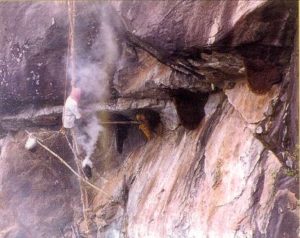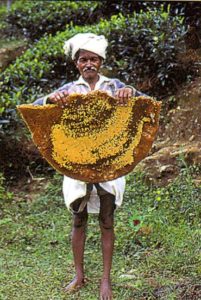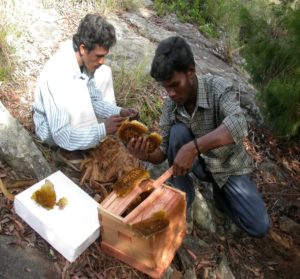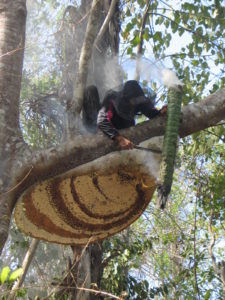 Honey as an NTFP is only found in South and South-east Asia from three indigenous bee species: Apis cerana, Apis dorsata and Apis florea. Apis mellifera is dominant in the rest of the world and has been domesticated and the strains modified to make them easy for humans to breed and become an income generating source. Large scale industrial growth of Apis mellifera has happened in the Europe, Africa and the Americas and apiculture is an important occupation for honey production and pollination. Currently, China is the largest producer of Apis mellifera honey in the world, followed by Germany. In India Apis mellifera has been imported and is widespread in the northern states and the Terai regions of India. Much of this honey is in the market as retail brands and used for exports.
Honey as an NTFP is only found in South and South-east Asia from three indigenous bee species: Apis cerana, Apis dorsata and Apis florea. Apis mellifera is dominant in the rest of the world and has been domesticated and the strains modified to make them easy for humans to breed and become an income generating source. Large scale industrial growth of Apis mellifera has happened in the Europe, Africa and the Americas and apiculture is an important occupation for honey production and pollination. Currently, China is the largest producer of Apis mellifera honey in the world, followed by Germany. In India Apis mellifera has been imported and is widespread in the northern states and the Terai regions of India. Much of this honey is in the market as retail brands and used for exports.
 Amongst the indigenous bees in Asia Apis dorsata or the Giant Rock Bee produces the maximum quantity of honey per hive. Their combs can be seen on high cliff overhangs or on tall trees. Usually, these tall tree-perches are on Terminalias or mango and other riverine trees in a tropical forest. Many forest communities harvest honey from these combs in dramatic and brave acts which involve hanging from great heights. Culturally, harvesting of this honey is specially organised by complex social formations, prayer, ritual and beliefs. In Asia the communities known to the NTFP Exchange Programme network, who specialise in this honeyhunting, are the Batak, Alu Kurumba, Jenu Kurumba, Sholiga, Kattunaicken, Cholanaicken, Chenchus and several Dayak communities in Kalimantan and Sarawak in Borneo.
Amongst the indigenous bees in Asia Apis dorsata or the Giant Rock Bee produces the maximum quantity of honey per hive. Their combs can be seen on high cliff overhangs or on tall trees. Usually, these tall tree-perches are on Terminalias or mango and other riverine trees in a tropical forest. Many forest communities harvest honey from these combs in dramatic and brave acts which involve hanging from great heights. Culturally, harvesting of this honey is specially organised by complex social formations, prayer, ritual and beliefs. In Asia the communities known to the NTFP Exchange Programme network, who specialise in this honeyhunting, are the Batak, Alu Kurumba, Jenu Kurumba, Sholiga, Kattunaicken, Cholanaicken, Chenchus and several Dayak communities in Kalimantan and Sarawak in Borneo.
Apis cerana is also harvested from forest areas by various forest-dwelling communities. It is a smaller bee that makes 6-9 combs as a colony and is found in the wild in tree cavities as well as in earth or stone hollows. This is the only indigenous bee that has been domesticated in Asia since traditional times. In the Himalayas these bees are domesticated in logs and made to live alongside the family in a wall hive. Other communities use pots or baskets to domesticate these bees. In the modern bee-keeping  world, this bee is also seen in Newton and Marthandam frame bee boxes. As an NTFP, some communities like the Toda and Mudhuva harvest honey from these colonies and have sustainable ways of managing their populations.
world, this bee is also seen in Newton and Marthandam frame bee boxes. As an NTFP, some communities like the Toda and Mudhuva harvest honey from these colonies and have sustainable ways of managing their populations.
Apis florea is the smallest bee of the Apis genera and has a distinct golden colour. This bee also builds a single comb and finds home in small bushes and low stone overhangs. Honey from these combs is less in quantity but considered medicinal and rarely sold.
Another source of honey comes from the Dammer bees, Melipona and Trigona species, which are tiny and fly-like, and can be seen nesting in walls, bamboo and stone structures. They can also be domesticated and among the Kathnaickens bamboo hives can be seen in their homes. The honey from these bees is also considered very medicinal.
India has all these indigenous bees which are found across most forested regions of the country. The habitat and the flowering plants determine which bees will be found in any locality. These insects are important pollinators of tropical forests and play a crucial role in its ecology, making sustainable harvesting a necessity for the sale and consumption of wild honey.
Forest honey in India is available through cooperatives, especially in states like Chattisgarh, Karnataka and Andhra Pradesh. The prices are usually high as there is a good demand for honey, both for retail and for the larger quantities demanded by the ayurvedic and herbal medicine industry. TRIFED has made interventions in training honey harvesters and providing them with gear and equipment to harvest hygienic honey. Interventions have also been made by the Khadi and Village Board to lay the standards of processing honey. However, this is controversial, as most communities believe that honey should not be heated as it changes its composition.
 In the Nilgiri Biosphere Reserve, Keystone Foundation has worked in this sector for over two decades and made many interventions. Many communities across the Reserve collect all 4 varieties of forest honey with each community having different their own knowledge and ways of harvesting the honey. The knowledge as well as the techniques have been documented and disseminated among the communities concerned with bees and honey. Honey was harvested traditionally but has had several problems relating to harvest and post-harvest handling, compounded with low rates and informal trade. Interventions were made in each of these phases, using aspects of traditional knowledge, appropriate technology and market intervention. Honey is presently collected by the Aadhimalai producer company in quantities ranging between 15-20 tons annually, through approximately 500 honey gatherers. Keystone has trained many groups and communities across Asia and developed a resource centre to share knowledge about forest honey.
In the Nilgiri Biosphere Reserve, Keystone Foundation has worked in this sector for over two decades and made many interventions. Many communities across the Reserve collect all 4 varieties of forest honey with each community having different their own knowledge and ways of harvesting the honey. The knowledge as well as the techniques have been documented and disseminated among the communities concerned with bees and honey. Honey was harvested traditionally but has had several problems relating to harvest and post-harvest handling, compounded with low rates and informal trade. Interventions were made in each of these phases, using aspects of traditional knowledge, appropriate technology and market intervention. Honey is presently collected by the Aadhimalai producer company in quantities ranging between 15-20 tons annually, through approximately 500 honey gatherers. Keystone has trained many groups and communities across Asia and developed a resource centre to share knowledge about forest honey.
Amongst the NTFP EP partners in India Samarthak Samiti, based in Udaipur, Rajasthan, works with honey gatherers. Here, Apis dorsata is found mainly on tall riverine trees and the honey season depends on the flowering of Madhuca indica, Pongamia pinnata, Azadirachta indica, khajur, khirni, palash, gulmohar and semal. On an average, 2-3 kgs of honey is collected per colony and a honey gatherer collects 40-50 kgs per season. Samarthak Samiti supports a cooperative of producers which buys the honey at the Minimum Support Price. Honey is also marketed through Desert Greens, the marketing brand promoted by the organisation. The Samiti also supports the honey gathering families through other development projects as well as insures them against accidents. Legal advice and negotiations with the forest department are also supported. In 2018, a total of 9 tons of honey was collected.
 In Yavatmal, the area that Gramin Smasya Mukti Trust (GSMT) works in, honey is collected from Apis dorsata and Apis florea. The collection is mainly from trees, where dorsata colonies have between 6-7 kgs per colony, and A. Florea between 250 to 500 gms. Neem, Palash and Jamun as the dominant species that flower in the summer months, providing nectar and pollen. Agricultural crops and fruit farms also help bee foraging. Honey gatherers go in groups and every person collects between 30-50 kgs and GSMT has supported them with training on sustainable harvesting, without destroying bees and helping them to get a good price. The past 2 years the rate has been ranging between Rs. 150-180 per kg in this region. The organisation directly buys 20-30 quintals of honey for processing and sale. The government is of late promoting beekeeping in this area with Apis mellifera, which is an Italian bee, exotic to Maharashtra and may cause extensive damage to local populations.
In Yavatmal, the area that Gramin Smasya Mukti Trust (GSMT) works in, honey is collected from Apis dorsata and Apis florea. The collection is mainly from trees, where dorsata colonies have between 6-7 kgs per colony, and A. Florea between 250 to 500 gms. Neem, Palash and Jamun as the dominant species that flower in the summer months, providing nectar and pollen. Agricultural crops and fruit farms also help bee foraging. Honey gatherers go in groups and every person collects between 30-50 kgs and GSMT has supported them with training on sustainable harvesting, without destroying bees and helping them to get a good price. The past 2 years the rate has been ranging between Rs. 150-180 per kg in this region. The organisation directly buys 20-30 quintals of honey for processing and sale. The government is of late promoting beekeeping in this area with Apis mellifera, which is an Italian bee, exotic to Maharashtra and may cause extensive damage to local populations.
In another area of the Western Ghats, our partner Appiko/Prakruthi has been working with both honey hunting and beekeeping. Though all 4 honey bees species are found in this region it is Apis dorsata and Apis cerana that provide most of the honey. The rock bee is found on large tropical rainforest trees and the honey is collected by expert honey gatherers, especially those of the Siddhi community. On an average 8-10 kgs of honey is collected per colony. The nectar and pollen from jamun, nandi and kurunji lends special taste to the honey here. A typical cerana colony yields an average of 2kgs per colony which brings in as much as Rs 350/kg. Wild rock bee honey sells for an average of Rs. 150/kg. Prakruthi does regular awareness campaigns, honey festivals and promotes the importance of bees.
Beekeeping is widely practiced in the mixed farms of this region of Uttara Kannada. There are many private initiatives taken by about 500 beekeepers in this region, including the making of boxes. The National Bee Board/horticulture college and the forest department also promotes beekeeping; however, they are destroying the beekeeping efforts in this region by donating bee-colonies infected by the Thai Sac Viral Brood (TSBV). This has resulted in the spread of the disease, which is negatively impacting older beekeepers.
Note: Please refer to the Honey Resource Book for more information. The desk can also have 23 other technical articles, books, manuals which can be referred to from Keystone Foundation
